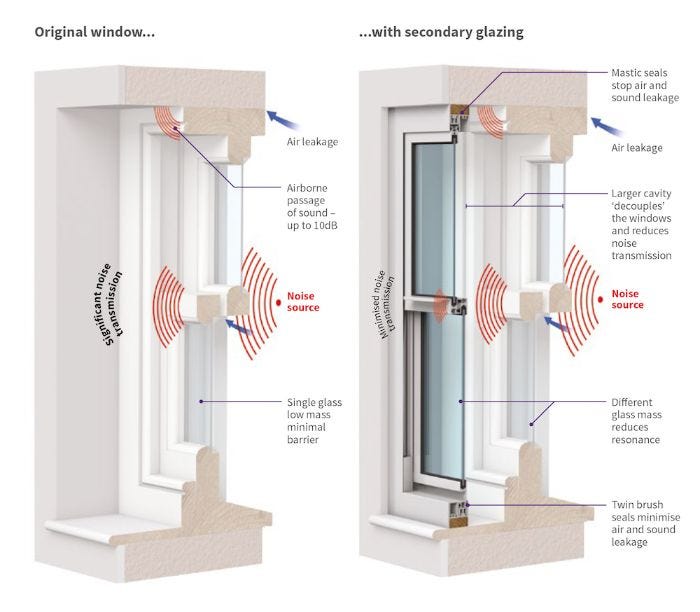Advancements in Acoustic Insulation with Glazing

Introduction
In today’s fast-paced urban environment, noise pollution is a growing concern for homeowners, businesses, and architects. The demand for effective acoustic insulation solutions has surged, and advancements in glazing technology are playing a pivotal role in reducing unwanted noise. Modern glazing solutions, including stained glass, leaded lights, and specially designed acoustic glass, are revolutionising the way we control sound transmission while maintaining aesthetic appeal and energy efficiency.
Understanding Acoustic Insulation with Glazing
Acoustic insulation refers to the ability of materials to reduce or block sound waves from passing through. Traditional glass installations, such as leaded lights and stained glass, were primarily designed for aesthetics and privacy, but with modern technological innovations, they now contribute significantly to noise reduction.
Double and triple glazing techniques, laminated acoustic glass, and specialised soundproofing interlayers have significantly enhanced the ability of glaziers to create effective sound-insulated spaces. By integrating these solutions, properties located in high-traffic areas, near airports, or in densely populated urban settings can enjoy greater peace and comfort.
Latest Trends in Acoustic Insulation with Glazing
1. Multi-Layered Glass with Acoustic Interlayers
Modern soundproof glazing solutions incorporate multiple glass layers with a specialised polyvinyl butyral (PVB) interlayer. These interlayers effectively dampen sound vibrations, reducing noise transmission by up to 50% compared to standard glazing.
2. Triple Glazing for Maximum Insulation
While double glazing has been the standard for many years, triple glazing is gaining popularity due to its superior thermal and acoustic insulation properties. The additional pane of glass and insulating gas layers contribute to an exceptional reduction in both noise and energy loss.
3. Sustainable and Eco-Friendly Materials
As sustainability becomes a major focus, glaziers are exploring recycled glass and eco-friendly materials to create noise-insulating glazing. Additionally, advancements in photovoltaic glass allow for dual functionality — reducing sound while generating solar energy, making buildings more energy-efficient.
4. Smart Glazing Technology
Recent innovations in smart glass allow for adjustable transparency and soundproofing. Some acoustic glazing solutions now integrate liquid crystal or electrochromic films, which not only provide privacy but also actively reduce external noise.
5. Stained Glass with Acoustic Benefits
Traditionally valued for its artistic appeal, stained glass is now being re-engineered with acoustic insulation properties. By incorporating double-glazing techniques or laminated acoustic films, stained glass can retain its visual charm while effectively reducing sound transmission.
The Role of Glaziers in Acoustic Insulation Solutions
Professional glaziers play a crucial role in the selection, customisation, and installation of soundproof glass. Their expertise ensures that clients receive tailor-made solutions suited to their specific acoustic insulation needs. With the industry moving toward sustainable glazing practises, experienced glaziers are now integrating advanced recycled and photovoltaic glass into modern designs.
Sustainability in Acoustic Glazing
1. Recycling Processes in Glass Manufacturing
One of the key trends in modern glazing is the focus on recycling processes. Manufacturers are utilising recycled glass materials to produce high-performance acoustic glazing solutions, reducing the environmental impact of new installations.
2. Eco-Friendly Laminates and Coatings
Newly developed sustainable laminates and coatings are now being used in soundproof glazing. These materials are not only effective in dampening noise but also reduce the carbon footprint of the manufacturing process.
3. Photovoltaic Glass: The Future of Sustainable Glazing
Photovoltaic glass, which integrates solar cells within the glazing panels, is a groundbreaking advancement in the industry. This technology not only enhances acoustic insulation but also generates solar energy, making buildings more energy-efficient and reducing reliance on traditional power sources.
Conclusion
As urban environments continue to grow, the demand for high-performance acoustic insulation with glazing is higher than ever. Innovations such as multi-layered glass, smart glazing, and photovoltaic technology are paving the way for quieter, more sustainable living and working spaces. Professional glaziers are at the forefront of implementing these advancements, ensuring that stained glass, leaded lights, and other glazing solutions are not only aesthetically pleasing but also functional in noise reduction. By embracing sustainable materials and cutting-edge technology, the industry is making significant strides toward eco-friendly and highly effective acoustic insulation solutions for the future.



Comments
Post a Comment